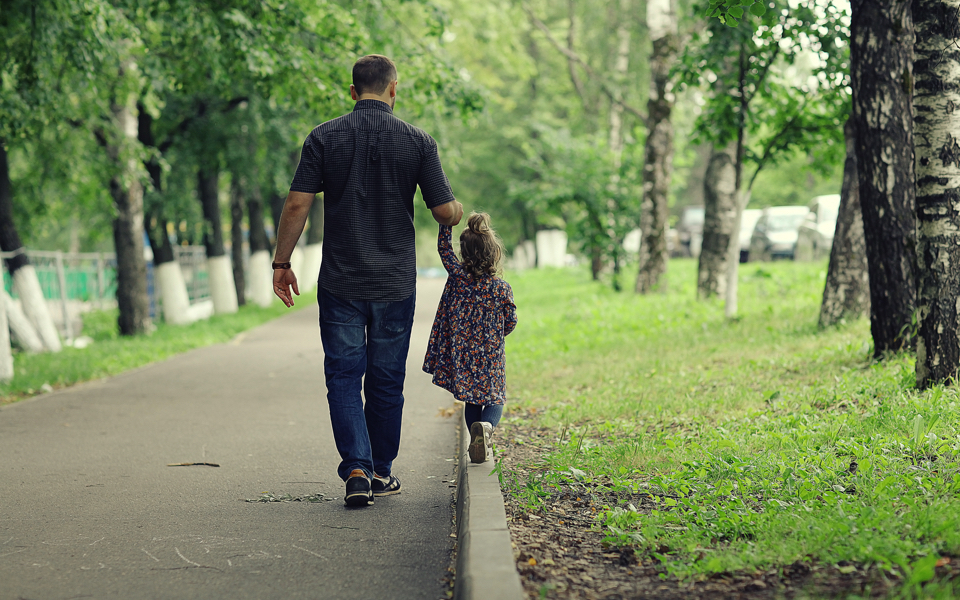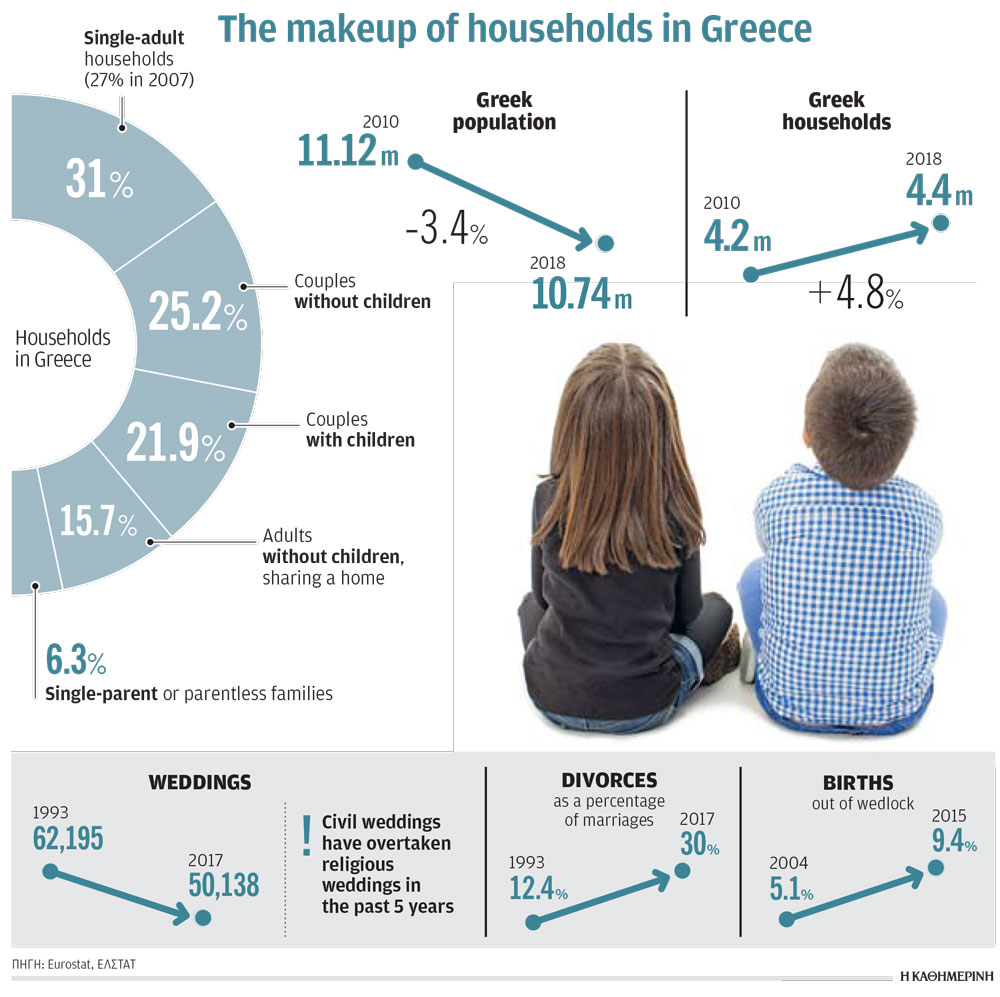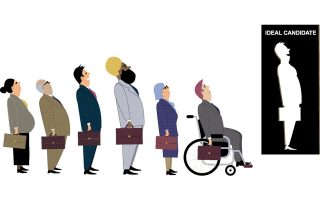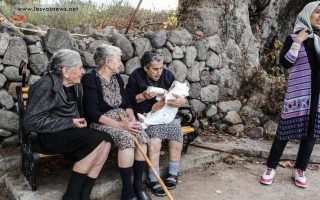The changing Greek family

The Greek family is changing dramatically. More single-person households, fewer weddings, more divorces, more single-parent families, more births out of wedlock, apartment-sharing, cohabitation pacts, childless couples: The traditional nuclear family is constantly losing ground.
The majority of households in Greece today are single-person: a man or a woman who chose to or ended up living on their own. According to Eurostat, the European Union’s statistics office, the share of single-person households rose by four percentage points between 2010 and 2017, reaching 31 percent. The next largest group is married couples without children, who account for 25.2 percent of all households (up from 24.1 percent in 2007). They are followed by married couples with children, who account for 21.9 percent of the total (down from 23.2 percent in 2007). In fourth place, accounting for 15.7 percent of the total, are unmarried couples without children.
The number of marriages dropped from 62,195 in 1993 to 50,138 in 2017, according to figures from the Hellenic Statistical Authority (ELSTAT). Civil weddings (which cost less and involve less bureaucratic hassle) have overtaken religious weddings over the past five years, with 25,163 ceremonies recorded in 2017 compared to 24,975 religious weddings.
Meanwhile, divorces increased from 7,725 in 1993 (or a crude divorce rate of 12.4 percent), to 13,494 in 2005 (22.1 percent), rising to around 15,000 per annum (30 percent) during the years of Greece’s financial crisis. The number of divorces only fell in 2016, reaching 11,013. Meanwhile, according to the same ELSTAT data, the number of cohabitation agreements soared – from 581 in 2013 to 4,921 in 2017.
Births outside of wedlock also grew from 5.1 percent of the total in 2004 to 9.4 percent in 2015, according to the latest available figures from Eurostat. Single-parent households increased from 1.8 percent to 2.3 percent in 10 years. Overall, 6.3 percent of all households currently comprise single-parent families and other types of households.
An example
Over the past two-and-a-half years Gianna has lived with Michalis and her daughter Sappho. She met Michalis after the birth of her daughter. Gianna later found out that Michalis used to be friends with her ex-husband and Sappho’s father, Christos. At the same time, Gianna and Michalis are close friends with Irene, who has known Michalis since they were both students abroad, and Giorgos. Irene and Giorgos are not a couple, but childhood friends. They are both divorced and decided to share an apartment to cut down on expenses, but also to keep each other company. Giorgos drops his kids off at Gianna and Michalis’s house on weekends. Irene’s ex-husband, Panos, who has just moved in with his new partner, often visits them at their place.
“Contemporary Greek society is changing,” Vasso Artinopoulou, a professor in the Sociology Department at Panteion University, told Kathimerini.
“Different types of family structures harmoniously coexist today – childless singles, single parents with a child or children, couples with or without children and with or without a cohabitation pact, same-sex couples and so on – along with the nuclear, four-member family and other traditional models,” Artinopoulou said.
“There are many reasons why mostly young people are drawn to these different family structures: economic, social, cultural or purely practical, pragmatic reasons. Two young people with jobs often decide to move in together in order to save money; they do not choose to have a traditional wedding with costly banquets and ceremonies. They adapt their daily needs to a small apartment; they resort to sustainable, low-cost solutions for their shared life. They are driven by pragmatism, they do not fantasize about getting married as a special once-in-a-lifetime event – a wedding as a ceremonial procedure has lost much of its appeal among younger people. Their aspirations are more pragmatic,” she said.
Artinopoulou says that this new reality is connected to the declining birth rate and the rise in divorces and single-parent families. The crisis has had a significant and multifaceted impact on Greek families – not only on an economic level, but also on the level of society and values. “The crisis in relationships is clear and undisputed: There is a lower level of communication, a lack of trust – these are all elements that are reflected in Eurostat surveys,” Artinopoulou said. This crisis is having a strong effect on decision-making regarding sharing a life together, particularly among young people. Moreover, the increasing rate of divorce, including those which are not made public for financial reasons, indicate that there are deep cracks in the family – “cracks that reflect the broader value crisis in society,” she said.

Αn institution in crisis
Greek society did not collapse during the unprecedented economic crisis due to the fact that the Greek family functions. It provides for good relationships and affection. At the same time, it is a world of contradictions, and turmoil, according to Ira Emke-Poulopoulos – professor at the University of Paris, member of the the New York Academy of Sciences and vice president of the Hellenic Society of Demographic Studies – in her study “Greece’s Population Under Persecution.”
She notes that the traditional nuclear family is still the norm but highlights the rise of single-parent families and births outside marriage as well as the drop in the number of large families.
The form of the Greek family is changing and the factors that have contributed to this, according to Emke-Poulopoulos, are the reduction in the average number of children each family has, demographic aging and higher life expectancy, the evolution of the economy from agricultural to industrial, a rapid rise in education levels, the democratization of interpersonal relationships, and working mothers.
As in other European countries, she said “the institution of marriage is going through a crisis. Marital partnerships are fewer, involve older people and are proving increasingly fragile.”
“The number of unmarried couples living together is rising as people postpone marriage or decide to never marry.”
Demographic, institutional (cohabitation, marriage and divorce laws), economic, social and cultural factors all contribute to the drop in marriages, Emke-Poulopoulos adds.
Similar factors also contribute to fewer births.
While on the one hand it has been observed, especially during the crisis, that people are forced by economic circumstances not to have children, on the other hand it is also a fact that “economic prosperity limits births.” As stated in the survey, “many parents prefer to buy or change a car, buy a cottage or new furniture rather than have another child.”
European trends
Europe is gradually becoming a region of singles, according to the latest Eurostat data, which show that single-resident homes have become the continent’s dominant type of household.
While the percentage in Greece is below the EU average of 33.6 percent, at 31 percent, this ratio is much higher in other countries, especially in Sweden (51.4 percent), Denmark (44.4 percent), Lithuania (42.5 percent), Finland (41.3 percent), Germany (41.2 percent) and Estonia (39.9 percent).
It is only natural therefore that we are seeing a rise in household numbers – with significant demographic, social, economic and environmental consequences – together with a reduction in the size of families.
In 2017, the average EU family had 2.3 members compared to 2.4 a decade earlier. The shift was more dramatic in Greece, where the average family size shrank from 2.7 members in 2005 to 2.5 in 2007 and 2.3 in 2017.
The largest family units were seen in Croatia, where the average in 2017 was 2.8, and the smallest in Sweden (1.9), Germany and Denmark (both 2), though the biggest drop was recorded in Lithuania, where the average family size contracted from 2.6 members in 2007 to 2.1 in 2017.
It is also striking that two-thirds of households in the EU28 consist of just one or two people. Single-person households, in fact, rose by 3.7 percentage points in the 2007-17 period, while two-person households rose 0.8 points to 31.9 percent. Households comprising three people accounted for just 15.6 percent of the total in the bloc, with four-person households at 13.1 percent and five-plus at just 5.8 percent.
As a result, the number of households as a whole has increased in the EU28 from 201 million in 2007 to 221 million in 2017 (up 1.01 percent annually). In Greece, they rose from 4,280,800 to 4,393,900 in that same period. In percentage terms, the biggest increase was in Cyprus (2 percent annually) and Slovenia (1.8 percent), while only Croatia saw a drop, of 0.31 percent per year.
Households with children make up 29.6 percent of the total in the European Union and 28.2 percent in Greece, while the list is led by Ireland (40.2 percent), Poland (37.4 percent) and Cyprus (36.7 percent). Coming in below Greece are Germany (22.3 percent) and Finland (21.9 percent). Outside the EU, Turkey leads, with 51.9 percent of its households including children, followed by the Former Yugoslav Republic of Macedonia (49.5 percent).
The most common type of household in the category of those with more than one adult is a couple without children, the data show, with such an arrangement representing 24.9 percent in the bloc and 25.2 percent in Greece. Couples with children make up 20 percent of adult households in the EU and 21.9 percent in Greece. The countries with the smallest percentages of couples with children are Lithuania (14.3 percent) and Bulgaria (14.5 percent). Meanwhile, though Ireland has the highest rate of households with children, at 40.2 percent, it has also seen a rise in single-parent families, to 6.3 percent, close to the figures of Sweden (6.4 percent), the UK and Estonia (6.6 percent each). The highest rates are in Denmark (8.6 percent) and Lithuania (7.2 percent), while the lowest are in Croatia (1.9 percent) and Finland (1.8 percent).





